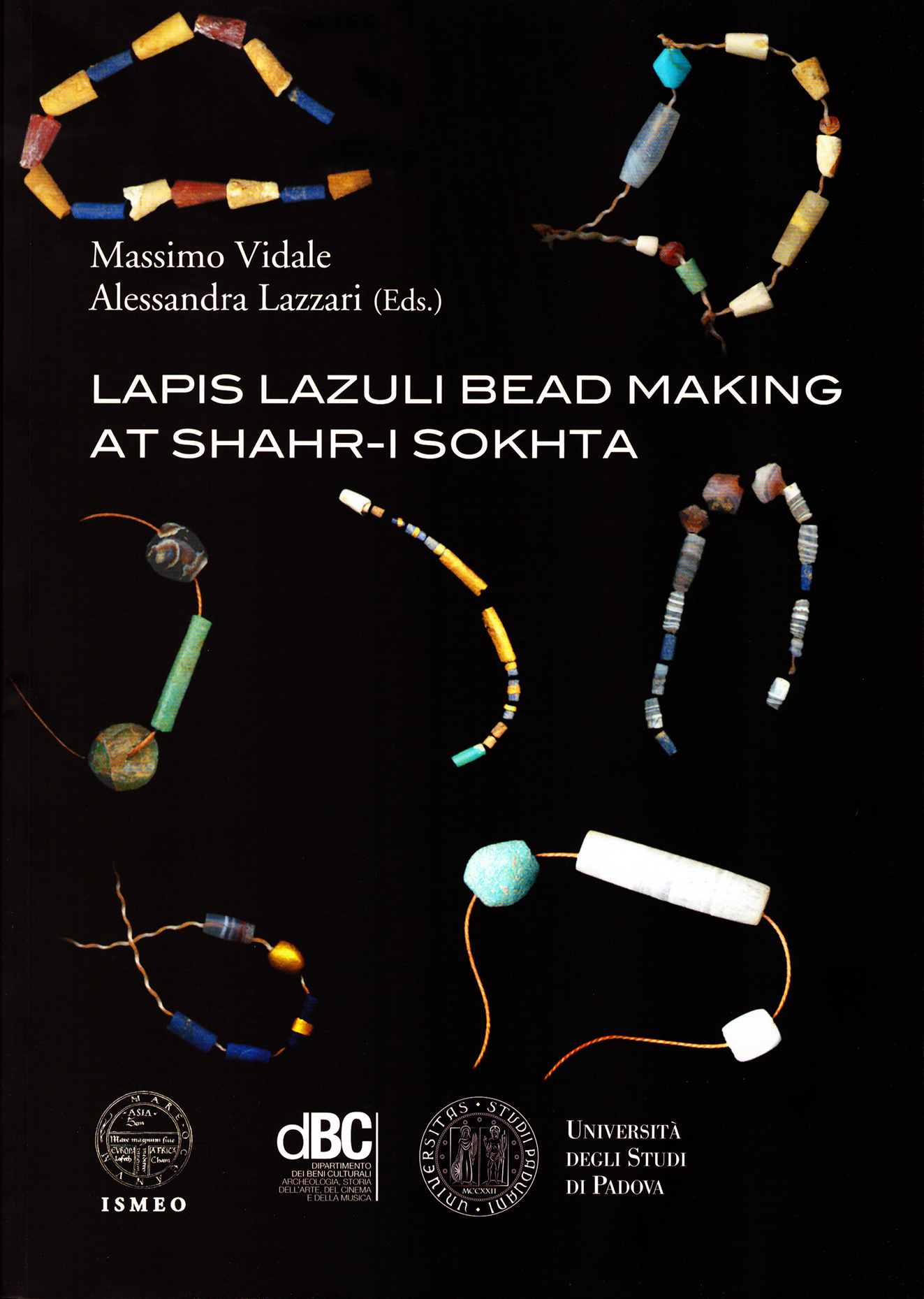Lapis Lazuli Bead Making at Shahr-i Sokhta. Interpreting Craft Production in a Urban Community of the 3rd Millennium BC,
Serie Orientale Roma 6, Antilia/ISMEO, Padova
- Anno: 2016
- Autore/i: M. Vidale, A. Lazzari (a cura di)
- Catalogo: ISMEO - Associazione Internazionale di Studi sul Mediterraneo e l'Oriente
- Argomento: Orientalistica
- Collana: Serie Orientale Roma
- ISBN: 978-88-97336-56-3
- ISSN:
CONTENTS
INTRODUCTION
y M. Vidale
CHAPTER 1
SHAHR-I SOKHTA: EARLY DISCOVERIES AND EXPLORATIONS
by A. Lazzari & M. Vidale
A season of discoveries
A stone cutter’s hoard, 2700-2600 BC (1968)
Archaeological record of bead-making: wooden tablets for holding beads
On the tracks of the drill stone sockets
The identification of the lapis lazuli workshop area in squares EWK-EWP (September 1972)
Craftsmen’ graves (1972, 1975 and later)
Lapis lazuli goods in the graveyard
Historical explanations …
… and the myth of Aratta
CHAPTER 2
MATERIALS AND METHODS
by A. Lazzari, L. Foglini & M. Vidale
Towards new stages of research
Study background
Organizing a general data base: the materials in the Rome collections
Excavations records: field book, sketches, maps and sections
Methods of analysis
CHAPTER 3
THE EXCAVATION OF THE EWK-EWP LAPIS LAZULI WORKING AREA
by M. Vidale
The excavation
Stratigraphic units in the main section and in plan
Archaeological sequence and stratigraphic formation processes
A synthesis: Period II in EWK
A comparison: the lapis lazuli working area of Tepe Hissar
Period III in EWP
CHAPTER 4
OF POTTERY AND TIME
by M. Vidale & A. Lazzari
Ceramics
Information on pottery provided by the field books
Chronological implications
Absolute chronology: radiocarbon datings and correlation with the ceramic evidence
CHAPTER 5
CRAFT ACTIVITIES: CHERT-CHALCEDONY PROCESSING AND USE
by L. Foglini & M. Vidale
A neglected field of study
The finds in EWK-EWP and the role of silicon oxides
The chert-chalcedony industry: materials and methods
Raw materials
Palaeotechnological types and operational sequences
Cores
Flakes and blades: typometric study
Flaking rejects
Microfragments of retouched objects or edge-damaged artefacts
Retouched artefacts and other tools
Drill heads: types and raw materials, production, use, consumption and breakage
A note on cylindrical drill heads in South Asia
Type 1 drill heads date back to Period III
Type 1 drill heads in detail
Type 2 drill heads
CHAPTER 6
THE LAPIS LAZULI INDUSTRY
by M. Mariottini, G. Della Ventura, A. Sodo & M. Vidale
Basic terminology
The stone: nature, mining areas, variability
Previous chemical analyses
Characterizing lapis lazuli from EWK-EWP: preliminary XRD analysis of a few selected samples
Burning marks and the question of pyrotechnological treatment of the lapis lazuli industry from EWK-EWP
Palaeotechnological types and lapis lazuli products: the assemblage
Ordering the craft indicators
Bead types: local production versus internal consumption
Production of blanks for cylinder seals?
CHAPTER 7
THE LAPIS LAZULI BEADS MANUFACTURING SEQUENCE, AND SPATIAL PATTERNING OF ITS RECORD
by M. Vidale, L. Foglini & G. Guida
A question of preforms
From ‘tablets’ to square-section blocklets: the evidence of grooving-and-splitting
Some experimental replications
Shaping by grinding and more grooving-and-splitting
Drilling
Wear traces and drilling powders: preliminary ESEM observation of a selected group of drill heads
Finishing the beads: smoothing and polishing
Spatial patterning of the lapis lazuli industry: general expectations
Spatial variability across the excavated contexts and its implications
CHAPTER 8
LAPIS LAZULI TECHNOLOGY: OTHER ISSUES, FINAL RECONSTRUCTION
by M. Vidale
On the evidence of the grooving-and-splitting technique in Central and South Asia
Comparisons with Tall-I Malyan, Tepe Hissar and Mohenjo-Daro
Identification of a quartzose rock containing corundum
An open question: the possible use of copper tools
On the use of burins in the reduction sequence
Final reconstruction
CHAPTER 9
THE TURQUOISE INDUSTRY
by L. Foglini & M. Vidale
Raw materials and its variability
General features and composition of the studied sample
A reconstruction of the bead reduction sequence
Spatial patterning of the turquoise industry across the excavated context
Internal consumption versus production
CHAPTER 10
OTHER RAW MATERIALS AND MANUFACTURING CYCLES
by L. Foglini & M. Vidale
Chalcedony and agate
Alabaster (translucent banded travertine)
Other stones: aragonite
Sandstone, basalt, steatite, other green stones
Evidence of metallurgical activities and copper products
CHAPTER 11
A LATE ADDITION: ANOTHER SAMPLE OF THE EWK-EWP INDUSTRY
by G. Murari, I. Angelini
A second look to the variability of chert/chalcedony
More blades and flakes
Retouched microblades and drill heads
Lapis lazuli industry
CHAPTER 12
NEW INTERPRETATIONS
by M. Vidale
Further remarks on the archaeological context of Period III in EWP
Comparisons with the sequences of the Central Quarters and the Eastern Residential Area
The limited record of administrative activities
New questions on the ‘world system’ view of South Asia in the 3rd millennium BC
Conclusions: disentangling specialization, standardization, efficiency in ancient craft production
APPENDIX
NEW EXCAVATIONS AT SHAHR-I SOKHTA: MORE GRAVES WITH LAPIS LAZULI BEADS, AND OTHERS WITH BEAD MAKING CRAFT INDICATORS
by S.M.S. Sajjadi
Socio-economical implications
COLOR PLATES
BIBLIOGRAPHY
INDEX
F.to 17x24, Brossura filo refe



